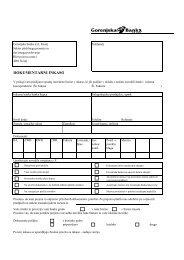Create successful ePaper yourself
Turn your PDF publications into a flip-book with our unique Google optimized e-Paper software.
The Bank has an established interest rate risk system in place to ensure the adequate net interest<br />
rate income level, and the adequate bank capital level in the context of interest rate fluctuations. The<br />
Bank’s policy is to regularly monitor and control the Bank’s interest rate risk exposure, to develop<br />
interest rate growth scenarios and to prepare measures for the instances of interest rate movements<br />
that would have severe negative consequences for the net interest rate incomes and bank capital.<br />
To ensure the realization of the interest rate risk management directions and the annual business<br />
plan, the Asset and Liability Committee was founded (hereinafter: ALCO). ALCO primary tasks are:<br />
• review of reports and preparations of interest rate risk measures,<br />
• review of balance and interest rate movements prognosis,<br />
• review of the Bank’s interest rate risk,<br />
• proposals on directions for interest rate fixing,<br />
• creation of risk exposure reduction measure,<br />
• creation of proposals on interest rate and market policy.<br />
Risk management provides the Management Board and ALCO with a monthly interest rate risk<br />
exposure analysis for reviewing. ALCO monitors and analyses interest rate risk at least on a monthly<br />
basis. It also reports to the Management Board and suggests measures in instances when the<br />
interest rate risk exposure exceeds or approaches the acceptable boundaries.<br />
One of the key interest rate risk exposure indications, apart from the time period of exposure, is<br />
the so-called stress test that denotes the impact of the yield curve parallel shift on the Bank’s net<br />
interest rate incomes and on economical capital value.<br />
Day-to-day management of the interest rate risk is the domain of the Bank’s treasury sector. Treasury<br />
sector is responsible for prevention of interest rate risk exceeding the set limits.<br />
Interest rate risk management is based on interest rate risk exposure limits. The Bank has a limit for<br />
the stress effect test that determines the highest permitted amount of loss by parallel yield curve<br />
shift, and limits with regard to time bands that are defined as the highest absolute value of the<br />
difference between asset items and liability items (balance and off-balance sheet), the interest rate<br />
of which changes in a particular time period or the items reach maturity in a particular time period.<br />
The table below summarises the Bank’s exposure to interest rate risks. It includes the Bank’s financial<br />
instruments at carrying amounts, categorised by the earlier of contractual repricing or maturity<br />
dates.<br />
Maturity dates do not differ significantly from the contract dates, except for the maturity of EUR<br />
428,100 thousands (2010: EUR 409,116 thousands) of due to customers up to one month, of which<br />
over two third represent current/settlement accounts considered by the Bank as a stable core<br />
source of funding of its operations.<br />
85<br />
<strong>Gorenjska</strong> <strong>banka</strong>, d. d., Kranj<br />
<strong>Annual</strong> <strong>Report</strong> 2011<br />
Financial <strong>Report</strong>



